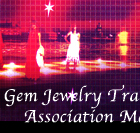| |
SYNTHETIC AND TREATED DIAMONDS: PAST,
PRESENT, AND FUTURE |
|
| |
Wilawan Atichat 1 Boontawee Sriprasert
1' 2
Research Team:
Wilawan Atichat 1, Boontawee Sriprasert 1' 2, Thidakorn Putharat 2, Thitinsee
Pawaro 1, Patra Srithunayothin 1, Asst. Prof. Dr. Pornsawat Wathanakul
1' 3, Assoc. Prof. Dr. Wisuth Pisuthi-Anont 1' 4, Archara Saeng-Ariyavanich
5, and Areeratt jfCornduangkaew' 5
1. Gem and Jewelry Institute of Thailand
2. Department of Mineral Resources
3. Kasetsart University
4. Chulalongkorn University
5. The Office of Atomic Energy for Peace
Beyond nature : Challenges ahead
Diamond is a special
gem, which is very popular and highly expensive due to its scarcity,
beauty, and durability. Diamond can be highly valued though it is small
in size. According to these factors, diamond has been made and known
as precious object for a long time. Generally, clarity, color, cut,
and carat or quality indicate value or price of diamond. Apart from
satisfaction, beauty, and quality of diamond, the most important factor
for diamond value is whether it is natural or not. In diamond trading
markets, its value and price mainly correlate with quality and beauty.
Anyhow, if the natural occurrence of diamond is concerned together with
those factors, its value and price will be increase definitely. If it
is so, there will be no or less problems. However, the problem which
may arise in the near future is how to test the natural occurrence of
diamond. In this modern world, research and new developments in technology
are highly progressed. Sooner or later, the difference between natural
and unnatural diamonds or other gems might be beyond the ability of
common people to identify.
As for the easy explanation,
but it might be difficult in practice, on how to distinguish real diamond
from fake diamond is the natural or man-made occurrence. Natural diamonds
must originate from nature, wherever sources or whichever countries
they are from. Only through the appropriate cutting process that make
diamond shine its glittering spark for the eyes of man. For unnatural
diamonds, we can divided them into three categories: (1) diamonds, which
are synthesized in the laboratory; (2) treated natural diamonds; and
(3) diamond simulants which look like or are similar to natural diamonds
but not their structure and composition.
It is found since the
year 2000 that the first two categories of unnatural diamonds have played
a pivotal role and increased fright in diamond trading markets. Treated
diamonds, such as irradiated diamonds, HPHT diamonds, and synthetic
diamonds from well-known manufacturers were sold increasingly in gems
markets. The consumers might have not been well informed or they could
not make the identification. Those unnatural diamonds are produced not
only in the Unites States by General Electric, Novatek, Chatham, Gemesis,
Apollo, Lucent, and by Sumitomo in Japan but also in Sweden, China,
Russia, India, and Korea. The testing method to identify whether it
is the natural diamond or treated diamond is now become highly complex
and requires advanced technology.
At present, the testing
for diamond if it is natural or unnatural needs "sufficient information
from the analysis in various aspects including specific physical, optical,
and chemical characteristic data, together with data obtained from advanced
tools such as UV-Visible-Near Infra-red Spectrometer and Fourier Transform
Infra-red Spectrometer, etc. The author and researchers have studied
on natural diamonds, treated diamonds, and synthetic diamonds for some
times in order to investigate and accumulate testing techniques for
separating natural from unnatural occurrence and color of diamonds.
Therefore, we would like to disseminate information on diamonds and
itsbeyonei-nature status, WnicYi Vs challenging to us all in the near
future.
|
|
| |
Treated diamond: similar to natural occurrence
|
|
| |
Diamond treatment is for at least two
aims. Firstly, to make diamond more beautiful(clear, colorless, sparkling,
or color enhancement). Secondly, to purify diamond. Sometimes, there might
be disputes between sellers and buyers who are not fully informed of the
treated diamonds in questions. The common diamond treatment process and
frequently found in gems markets is to make diamond cleaner and clearer.
For instances, filling with colorless substance in the crack or fracture,
and applying laser for eliminating the inclusion. The popular processes
to change diamond's color for commercial purposes are coating by synthetic
thin film diamond; irradiation with various techniques which change to
blue, green, brown, orange, yellow or black; annealing after irradiation
to produce green, brown, orange, pink, red, and purple; HPHT treatment
to produce colorless, yellow, and greenish yellow; and hybrid techniques
to produce pink, red to purple diamonds.
Most of the natural diamonds (approximately 98 %) are type la (Bruton,
1978; Field, 1992; Nassau, 1994) which contain about 5,000 atoms in
1 million atoms (approximately 5,000 ppm) of nitrogen as trace element.
They also have the structural defects at 4'15 and 340 nanometer, which
caused by aggregation replacement form of 3 atoms of Nitrogen. While
type Ib, Ila, and lib diamonds have Nitrogen in very small proportion
(40,20, and less type la diamonds are always in greenish yellow to yellow
tint color. Type la diamond treatment which includes brown diamonds
treated with HPHT Process can be changed to greenish yellow ( Reinitz
et al., 2000., Collins etal., 2000; and Hainschwang et
al, 2005). The hybrid process including irradiation, annealing,
HPHT, and low temperature low pressure annealing can change color of
diamonds to pink, purplish red and orange brown (Wang et al., 2005).
There is about 1 % of type Ib diamond from the natural diamonds in the
world. This type of diamond has single nitrogen atom as impurity, and
commonly found in yellow diamonds and synthetic diamonds.Type Ila diamond
is rarely found in the nature and it posses very little Nitrogen. By
HPHT treatment, it could be changed to colorless or white diamond (Moses, et al., 1999; Smith, et al., 2000; and Fisher and
Spits, 2000) or the brownish pink could be changed to pink diamond (Hall
and Moses, 2000).
Type lib diamond comprises of Boron element and is very rare. It is
often found in light blue to dark blue colors. The brownish blue diamond
could be changed to light blue color (Hall and Moses, 2000).
|
|
| |
Diamond treated by irradiation
|
|
| |
Color in the diamond occurs from two
causes: (1) impurity atoms; and (2) defects in diamond structure (caused
by natural radiation or 'irradiation 'tecnrirqire\). Tin^t "two causes
will form the color centers in diamonds and effect the ability of transparency
of white light spectrum in the diamond. The daylight, in fact, comprises
of seven visible colors that are violet, indigo, blue, green, yellow,
orange, and red (the visible range of light is 400-700 nanometer; the
invisible range is infra-red spectrum, which is more than 700 nanometer
and ultra-violet spectrum, which is less than 400 nanometer).
When the white light shed on diamond, the color centers(defect and impurity
atoms) will absorb some spectrums of the light and emit other spectrums,
which make us see the color of the diamond. In short, color of diamond
results from the visible light emitted or absorbed by impurity atoms and
structural defects in the diamond. The colorless diamond results from
the color centers emit all color spectrums in the light through the diamond.
Diamond treatment by electron, neutron, gamma and alpha particles
irradiation will cause structural defects in diamonds since these high
power rays could move the carbon atoms and push them into the interstitial
position. The absorption occurring with the vacancies in neutral status
will result in the absorption at 741 nanometer or GR1 Center(General
radiation); the shorter wavelength absorption such as GR2 to GR8 at
430 to 413 nanometer; and the absorption at 393 nanometer or ND1 Center
(Negative vacancy).
|
|
| |
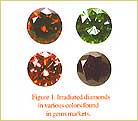 |
|
These kinds of absorption always cause the diamond to change
its color to green or greenish blue color. The examples of irradiated
diamonds found in the market are in green, blue, pink, red, and
black colors as feature in Figure 1.
The author and researchers conducted the experiments on irradiated
diamonds by neutron and electron irradiation in order to investigate
special characteristics as well as accurate and timely testing
method to distinguish irradiated colored diamonds from natural
colored diamonds.
|
|
|
| |
Neutron irradiation from the nuclear research reactor 1 at the Office
of Atomic Energy for Peace could be classified into two groups.
1 .Diamond irradiation at the external tube (CA" 3) by the nuclear
research reactor 1, the first improvement, at the Office of Atomic Energy
for Peace when there is epithermal neutron flux about 3.0 x 10 U neutron
per cm" 2 per second for 36 hours. The neutron fluences are about
3.89 x 10 16 neutron per cm" 2.
2. Diamond irradiation at the internal tube(CT) by the nuclear research
reactor 1, the first improvement, at the Office of Atomic Energy for Peace
when there is epithermal neutron flux about 2.8 x 10 13 neutron per cm"
2 per second for 12 hours. The neutron fluences are about 1.21 x 10 18
neutron per cm" 2. Most of the samples for neutron irradiation are
type la diamonds; laA, laB, and laAB. They fluoresce under long
wave ultra-violet in various colors such as light chalky blue, green,
and yellow.
|
|
| |
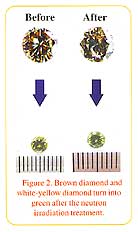 |
|
Most of
the neutron irradiated diamonds are green with different tones as
feature in Figure 2 '
As for the electron irradiation, it is conducted by the electron
accelerator kindly provided by IBA company in Rayong Province. On
the treatment, the electron irradiation dose about 120,000 kGy or
12,000 Mrad is used. The samples for electron irradiation are yellowish
white diamond; brown diamond; neutron irradiated diamond; and unidentified
irradiated diamond. The samples turn into green in different color
tones as feature in Figure 3.
The experiment on neutron and/or electron treated diamonds embedded
in graphite rod and annealed in the electric furnace at 650 degree
Celsius for 5 hours was conducted. By using this method, die green neutron and electron treated diamonds turned into brownish
yellow. The brownish red unidentified irradiated diamond turned
into dark red diamond as feature in Figure 4.
Figure 4. The green neutron and/or
electron treated diamond turned into brownish yellow and the brownish
red unidentified irradiated diamond turned into vivid red diamond
after annealing.
The reason why the color of irradiated diamonds has changed after
annealing treatment is because there had been the structural defects
in diamonds with nitrogen from electron irradiation treatment. The
irradiation will cause the vacancies, which are stable at the room
temperature. According to the annealing treatment, these vacancies
will move and will be caught by nitrogen in different forms in order
to form the new color centers. As for type Ib diamonds, the vacancies
caught by single nitrogen, will form the color center with the absorption
at 1.945 eV (637 nm, N-V), which will turn into pink or red. On
type la diamonds, the vacancies caught by nitrogen in A or B aggregate,
will form the color center with the absorption at 2.463 eV (503
nm, N-V) or namely H3, center, ami 1.499 e-V (495 ?M «m namely
H4 center. The absorption at H3 or H4 center will turn the diamonds
into yellow, orange, or brown depending on its original color prior
to the irradiation and the intense of the absorption caused by the
defects from irradiation and annealing treatments.
The reason why the color of irradiated diamonds has changed into
green or yellow after annealing treatment is because the nitrogen
might be at atomic vacancies, among interstitial or as aggregation
of nitrogen or single nitrogen. When neutron or electron irradiation
enter into diamond, they will cause vacancies or defects
inside it. This kind of irradiation treatment will show the
spectrum at 393 (ND1), 595, 741 (GR1) nm. If annealing these irradiated
diamonds, the vacancies will move and penetrate into their atomic
structure. The moving vacancies will be caught by other defective
structures(usually by nitrogen). This will cause the complex nitrogen
vacancy combination of color center. These irradiated and annealed
diamonds will show the absorption of UV-VIS NIR at 595, 503, and
496 nm; the absorption of Mid Infra-red at 4940 (Hlb)and5170(Hlc)cm-
1. |
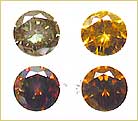 |
|
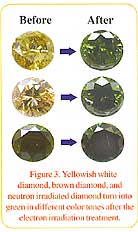 |
|
|
|
| |
Diamond treated by high pressure and high temperature (HPHT)
|
|
| |
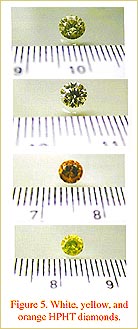 |
|
It is found that high
pressure high temperature treated diamond or HPHT diamond can be
seen in every color such as colorless, yellow, greenish yellow,
yellow-green, pink, and blue. The majority of HPHT diamonds with
the GE POL trademark produced by Pegasus Overseas Limited (POL)
and General Electric Company(GE) Laboratory are natural type lla
diamonds and mostly weigh less than 2 carats. They mostly appear
in fancy cuts(oval, marquise, and pear) and almost in coloiless
ot nearly coloiless(D-G). It is likely that they are of the clarity
grade range from IF or VVS1 to VVS2, VS1, and VS2 for the rest.
Looking inside, these diamonds have graining and a little bit blemishes.
Under the Polariscope, the twisted cross (Hour-glass like), the
stripe or spot arrangement and gray, blue and orange strain colors,
are found. Most of them do not fluoresce under ultra-violet light
and have Raman peak at 3760 cm- 1.
Apart from HPHT colorless diamonds from GE POL, the Nova Diamond,
the company manufacturing of HPHT colored diamonds, has produced
HPHT green as well as yellow diamonds from brown diamonds and launched
into the market. The diamonds being used by Nova Diamond for HPHT
treatment are type la diamonds, which comprise of nitrogen impurity
atoms and they are 98 % of the world's naturally found diamonds.
As a result, it is more difficult and more challenging to identify
HPHT diamonds from natural diamonds.
The test of colorless diamonds and fancy colored diamonds whether
they are natural occurrence or not is one of the hardest tasks.
Since there is no HPHT facilities in Thailand, the experiment on
HPHT diamonds could not be conducted. Therefore, the author and
researchers have to find HPHT diamonds to study and compare so as
to search for testing techniques. Fortunately, the manufacturer
kindly provided samples of HPHT diamonds .tor. this, stiujy which
are in white, yellow, and orange colors as shown in Figure 5. |
|
|
| |
Summary
of the result from the
study on HPHT diamonds |
|
| |
 |
|
1.
Most of HPHT colorless diamonds are type JTa diamonds, which usually
have brownish in the first stage the test to check whether or not
they are type Ha diamonds must be conducted by using the Fourier
Transform Infra-red Spectrometer. Unlike colorless natural type
Ha diamonds (as shown in Figure 6), HPHT colorless diamonds have
the absorption spectrum of UV-VIS-NIR at 270 nm. and they must have
the spectrum of photoluminescence prominent at 637 nm.
2. The HPHT greenish yellow or yellowish green diamonds are
normally treated from brown type la diamonds (contain nitrogen)
as shown in Figure 7. From the test, the absorption spectrum of
UV-VIS- NIR at H2 (986 nm) is not found but it is found prominently
at H3 (503 nm).
3. HPHT intense yellow diamond treated from light yellow type la
diamond is featured in Figure 8. Mostly, the yellow diamonds, with
similar or the same spectrum as the natural yellow diamonds, are
resulted from the treatment. They tend to fluoresce under the longwave
ultra-violet light. The HPHT diamonds treated from the light yellow
type la diamonds are likely to have the absorption spectrum of Mid
Infra-red at 1344 and 1480cm- 1.
4.The experiment on annealing HPHT diamonds at 650 degree Celsius
for 6 hours is conducted to stn4v the color change. The studv
found that the color of the diamonds remains unchanged and the
UV-VIS-NIR absorption spectrum at 41 5 and 503 nm. is not changed.
However, the Mid Infra-red absorption spectrum at 668 and S48
citt' is found in some samples.
The examination of treated diamonds with basic methods such
as characteristic ompurity; fluorescence under the ultra-violet
light; color zoning; and strain structure in diamond, which are
similar to anomalous double refraction, are the important indicators
or clues for further study by using various spectroscope techniques,
which are accurate, timely, and also costly. Advanced spectroscopic
techniques applied in diamond testing include the analysis of
Mid Infra-red absorption with the Fourier Transform Infra-red
(FTIR) Spectrophotometer; the analysis of UV-VIS-NIR absorption
with the ; UV Visible Spectro- photometer (UV-VIS-NIR); and the
analysis of Photoluminesence spectrum with the Laser Raman Spectrometer.
In addition, the classification of diamond; the luminescence spectrum;
and other specific features could be tested by the Cathodoluminoscope
in order to acquire all necessary information for the examination.
( To be contine next Issue )
|
|
|
|




